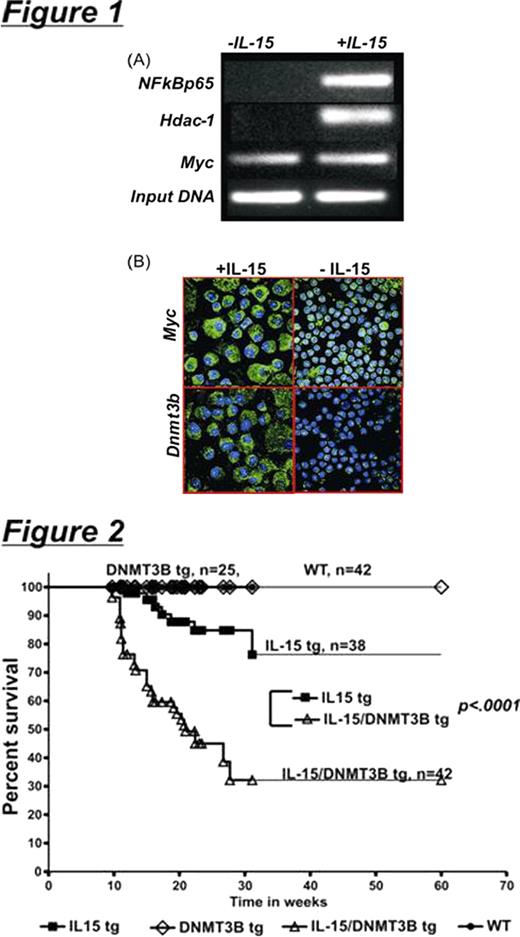Abstract
Abstract 704
Interleukin (IL)-15 is critical for the differentiation, proliferation, activation and survival of large granular lymphocytes (LGL). Malignant blasts from patients with acute LGL leukemia (LGLL) can express membrane bound IL-15 and often require IL-15 or IL-2 to survive and expand in vitro, suggesting a pivotal role of IL-15 in the genesis of LGLL in vivo. Indeed, 30% of mice engineered to over express IL-15 develop LGLL (J Exp Med 193:219-231, 2001), suggesting that IL-15 is a proto-oncogene. The present study examined the mechanism by which this may occur in mouse and in man. We observed ~2.5-fold increased levels of DNA methyltransferase 3b (Dnmt3b) in IL-15tg mice with LGLL compared to wild type (Wt) splenocytes (2.6 ± 0.6 -fold higher, N = 3 each, P =.03) and a ~2-fold increased levels of global DNA methylation (GDM) compared to Wt splenocytes (% global DNA levels measured by mass spec as % 5mC/(5mC+2dC): 3.6 ± 0.11%, N = 4 for IL-15tg LGLL; 1.5 ± 0.08%, N = 4 for Wt, P <.0001). Remarkably, samples from three LGLL patients exhibited significantly increased levels of DNMT3B when compared to their normal donor counterparts, ranging from 38-fold to 5448-fold (P <0.008), and a significant increase in GDM (4.4% ± 0.01 N = 3 for LGLL patients; 4.2 ± 0.01% N = 3 for normal donors, P =.008). Dnmt3b is negatively regulated by miR-29b, which is under the regulation of Myc (Nature Genetics 40:43-50, 2008). Blasts from both IL-15tg LGLL mice and LGLL patients had a significant decrease in miR-29b expression when compared to their Wt LGL and normal donor counterparts respectively (2-fold lower in mouse, P <.02; 11 to 230-fold lower in human samples, N = 3 each, P <.0009). This was accompanied by increased expression of Myc in LGLL samples (mouse LGLL: Wt LGL = 10.4 ± 1.3-fold higher, N = 3 each, P < 0.005; human LGLL: normal donor LGL = 7.7 ± 1.6 -fold higher, N = 4, P <.0015). Since IL-15 signaling appears important in development of LGLL we investigated the oncogenic effect of IL-15 by culturing sorted mouse Wt (NK1.1+) LGLs in medium supplemented with 10% FCS and 100 ng/ml IL-15. Within 12 hours of culture, these IL-15–stimulated Wt LGLs displayed 2.0 ± 0.5-fold lower levels of miR-29b due to increased binding of a repressor complex that included Myc in addition to NFkBp65 and Hdac1 at the miR-29b promoter (Fig. 1A). By day 30 of Wt LGL culture in IL-15, we observed a 2.6 ± 0.6-fold mRNA increase in Dnmt3b (N=3, P=.03) and a 10.4 ± 1.3-fold increase in Myc (N = 3, P < .005) compared to fresh Wt LGL, also confirmed at the protein level (Fig. 1B, green color). Compared to fresh Wt LGLs, day 30 IL-15-stimulated Wt LGLs exhibited a significant increase in GDM measured by mass spectrometry (%GDM: 2.5 ± 0.3 in stimulated Wt LGLs, N = 4, vs 1.5 ± 0.08 in non-stimulated Wt LGLs, N = 4, P <.01). Over several months, the IL-15-stimulated Wt LGLs continued to expand and accumulate centrosome aberrations and aneuploidy, with over expression of Aurora kinase B when compared to fresh Wt LGLs (170.5 ± 58.23 -fold higher, N = 3, P = .02). SCID mice injected with these transformed cells died of LGLL in the absence of exogenous IL-15. Thus, chronic in vitro exposure of Wt LGLs to excessive IL-15 results in leukemic transformation via a process that likely includes decreased miR-29b, increased Dnmt3b, global DNA hypermethylation, centrosome aberrations and chromosomal instability. To address the in vivo role of DNMT3B in IL-15-mediated leukemogenesis, we created DNMT3Btg mice under a vav-1 promoter. DNMT3Btg mice had normal survival at 2 years, while IL-15/DNMT3Btg mice showed a significantly lower latency and higher incidence of LGLL compared with IL-15tg mice (median survival: 20.7 wk in IL-15/DNMT3Btg vs 31.1 wk in IL-15tg, P <.0001; Fig. 2). Thirty-one of 42 (73%) IL-15/DNMT3Btg mice died of LGLL compared to 8 of 38 (21%) IL-15tg mice. Leukemic blasts from LGLL mice demonstrated excessive expression of Aurora kinase B over Wt splenocytes (257.7 ± 39.4 -fold higher, N = 3 each, P = .01) and aneuploidy. Collectively, we provide evidence that IL-15 is a proto-oncogene: excessive expression of this lymphocytotropic cytokine results in activation of a repressor complex that decreases expression of miR-29b, induces Dnmt3b expression, global DNA hypermethylation, aberrant centrosome formation, aneuploidy and leukemic transformation. We provide evidence for these mechanisms in both in vitro and in vivo mouse models as well as in primary LGLL patient samples.
No relevant conflicts of interest to declare.
Author notes
Asterisk with author names denotes non-ASH members.


